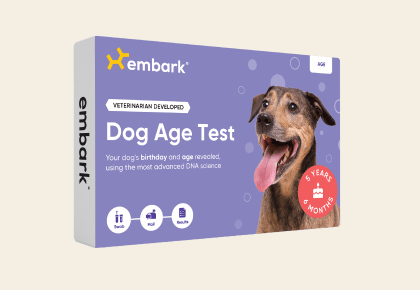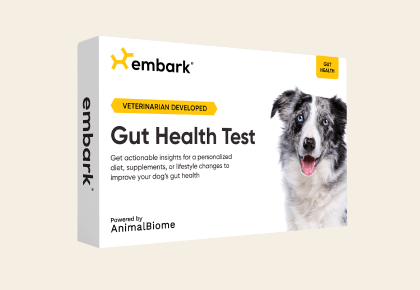Coat Color
-
E Locus (MC1R)
The E Locus determines if and where a dog can produce dark (black or brown) hair. Dogs with two copies of the recessive e variant do not produce dark hairs and will express a red pigment called pheomelanin over their entire body. The shade of red, which can range from a deep copper to white, depends on other genetic factors, including the Intensity loci. In addition to determining if a dog can develop dark hairs, the E Locus can give a dog a black “mask” or “widow’s peak” unless the dog has overriding coat color genetic factors.
Dogs with one or two copies of the Em variant may have a melanistic mask (dark facial hair as commonly seen in the German Shepherd Dog and Pug). In the absence of Em, dogs with the Eg variant can have a “grizzle” phenotype (darker color on the head and top with a melanistic "widow's peak" and a lighter underside, commonly seen in the Afghan Hound and Borzoi and also referred to as “domino”). In the absence of both Em and E variants, dogs with the Ea or Eh variants can express the grizzle phenotype. Additionally, a dog with any combination of two of the Eg, Ea, or Eh variants (example: EgEa) is also expected to express the grizzle phenotype.
Learn More: http://www.doggenetics.co.uk/masks.html
Citations: Anderson et al 2020, Dreger and Schmutz 2010, Schmutz et al 2003, Honkanen et al 2024, Durig N et al 2018 -
K Locus (CBD103)
The K Locus KB allele “overrides” the A Locus, meaning that it prevents the A Locus genotype from affecting coat color. For this reason, the KB allele is referred to as the “dominant black” allele. As a result, dogs with at least one KB allele will usually have solid black or brown coats (or red/cream coats if they are ee at the E Locus) regardless of their genotype at the A Locus, although several other genes could impact the dog’s coat and cause other patterns, such as white spotting. Dogs with the kyky genotype will show a coat color pattern based on the genotype they have at the A Locus. Dogs who test as KBky may be brindle rather than black or brown.
Learn More: http://www.doggenetics.co.uk/black.htm
Citations: Candille et al 2007 -
A Locus (ASIP)
The A Locus controls switching between black and red pigment in hair cells, but it will only be expressed in dogs that are not ee at the E Locus and are kyky at the K Locus. Sable (also called “Fawn”) dogs have a mostly or entirely red coat with some interspersed black hairs. Agouti (also called “Wolf Sable”) dogs have red hairs with black tips, mostly on their head and back. Black and tan dogs are mostly black or brown with lighter patches on their cheeks, eyebrows, chest, and legs. Recessive black dogs have solid-colored black or brown coats.
Learn More: http://www.doggenetics.co.uk/tan.html
Citations: Dreger and Schmutz 2011, Berryere et al 2005 -
D Locus (MLPH)
The D locus result that we report is determined by three different genetic variants that can work together to cause diluted pigmentation. These are the common d allele, also known as “d1”, and the less common alleles known as “d2” and “d3”. Dogs with two d alleles, regardless of which variant, will have all black pigment lightened (“diluted”) to gray, or brown pigment lightened to lighter brown in their hair, skin, and sometimes eyes. There are many breed-specific names for these dilute colors, such as “blue”, “charcoal”, “fawn”, “silver”, and “Isabella”. Note that in certain breeds, dilute dogs have a higher incidence of Color Dilution Alopecia. Dogs with one d allele will not be dilute, but can pass the d allele on to their puppies.
Learn More: http://www.doggenetics.co.uk/dilutes.html
Citations: Drogemuller et al 2007, Bauer et al 2018, Van Buren et al 2020 -
B Locus (TYRP1)
Dogs with two copies of the b allele produce brown pigment instead of black in both their hair and skin. Dogs with one copy of the b allele will produce black pigment, but can pass the b allele on to their puppies. E Locus ee dogs that carry two b alleles will have red or cream coats, but have brown noses, eye rims, and footpads (sometimes referred to as "Dudley Nose" in Labrador Retrievers). “Liver” or “chocolate” is the preferred color term for brown in most breeds; in the Doberman Pinscher it is referred to as “red”.
Learn More: http://www.doggenetics.co.uk/liver.html
Citations: Schmutz et al 2002, Hrckova Turnova et al 2017, Jancuskova et al 2018 -
Saddle Tan (RALY)
The "Saddle Tan" pattern causes the black hairs to recede into a "saddle" shape on the back, leaving a tan face, legs, and belly, as a dog ages. The Saddle Tan pattern is characteristic of breeds like the Corgi, Beagle, and German Shepherd. Dogs that have the II genotype at this locus are more likely to be mostly black with tan points on the eyebrows, muzzle, and legs as commonly seen in the Doberman Pinscher and the Rottweiler. This gene modifies the A Locus at allele, so dogs that do not express at are not influenced by this gene.
Citations: Dreger et al 2013 -
H Locus (Harlequin)
This pattern is recognized in Great Danes and causes dogs to have a white coat with patches of darker pigment. A dog with an Hh result will be harlequin if they are also M*m or M*M* at the M Locus and are not ee at the E locus. Dogs with a result of hh will not be harlequin. This trait is thought to be homozygous lethal; a living dog with an HH genotype has never been found.
Learn More: http://www.doggenetics.co.uk/harlequin.html
Citations: Clark et al 2011 -
M Locus (PMEL)
Merle coat patterning is common to several dog breeds including the Australian Shepherd, Catahoula Leopard Dog, and Shetland Sheepdog, among many others. Merle arises from an unstable SINE insertion (which we term the "M*" allele) that disrupts activity of the pigmentary gene PMEL, leading to mottled or patchy coat color. Dogs with an M*m result are likely to be phenotypically merle or could be "non-expressing" merle, meaning that the merle pattern is very subtle or not at all evident in their coat. Dogs with an M*M* result are likely to be phenotypically merle or double merle. Dogs with an mm result have no merle alleles and are unlikely to have a merle coat pattern.
Note that Embark does not currently distinguish between the recently described cryptic, atypical, atypical+, classic, and harlequin merle alleles. Our merle test only detects the presence, but not the length of the SINE insertion. We do not recommend making breeding decisions on this result alone. Please pursue further testing for allelic distinction prior to breeding decisions.Learn More: http://www.doggenetics.co.uk/merle.html
Citations: Clark et al 2006 -
S Locus (MITF)
The S Locus determines white spotting and pigment distribution. MITF controls where pigment is produced, and an insertion in the MITF gene causes a loss of pigment in the coat and skin, resulting in white hair and/or pink skin. Dogs with two copies of this variant will likely have breed-dependent white patterning, with a nearly white, parti, or piebald coat. Dogs with one copy of this variant will have more limited white spotting and may be considered flash, parti or piebald. This MITF variant does not explain all white spotting patterns in dogs and other variants are currently being researched. Some dogs may have small amounts of white on the paws, chest, face, or tail regardless of their S Locus genotype.
Learn More: http://www.doggenetics.co.uk/white.htm
Citations: Karlsson et al 2007 -
Intensity Loci
Areas of a dog's coat where dark (black or brown) pigment is not expressed either contain red/yellow pigment, or no pigment at all. Five locations across five chromosomes explain approximately 70% of red pigmentation "intensity" variation across all dogs. Dogs with a result of Intense Red Pigmentation will likely have deep red hair like an Irish Setter or "apricot" hair like some Poodles, dogs with a result of Intermediate Red Pigmentation will likely have tan or yellow hair like a Soft-Coated Wheaten Terrier, and dogs with Dilute Red Pigmentation will likely have cream or white hair like a Samoyed. Because the mutations we test may not directly cause differences in red pigmentation intensity, we consider this to be a linkage test.
Citations: Slavney et al 2021, Weich et al 2020, Hedan et al 2019 -
Cocoa (HPS3)
Dogs with the coco genotype will produce dark brown pigment instead of black in both their hair and skin. Dogs with the Nco genotype will produce black pigment, but can pass the co allele on to their puppies. Dogs that have the coco genotype as well as the bb genotype at the B locus are generally a lighter brown than dogs that have the Bb or BB genotypes at the B locus.
Learn More: http://www.doggenetics.co.uk/liver.html#cocoa
Citations: Kiener et al 2020 -
R Locus (USH2A)
The R Locus regulates the presence or absence of the roan coat color pattern. Partial duplication of the USH2A gene is strongly associated with this coat pattern. Dogs with at least one R allele will likely have roaning on otherwise uniformly unpigmented white areas. Roan appears in white areas controlled by the S Locus but not in other white or cream areas created by other loci, such as the E Locus with ee along with Dilute Red Pigmentation by I Locus (for example, in Samoyeds). Mechanisms for controlling the extent of roaning are currently unknown, and roaning can appear in a uniform or non-uniform pattern. Further, non-uniform roaning may appear as ticked, and not obviously roan. The roan pattern can appear with or without ticking.
Learn More: http://www.doggenetics.co.uk/ticking.html
Citations: Brancalion et al 2021, Kawakami et al 2021 -
Panda White Spotting
Panda White Spotting originated in a line of German Shepherd Dogs and causes a mostly symmetrical white spotting of the head and/or body. This is a dominant variant of the KIT gene, which has a role in pigmentation.
Dogs with one copy of the I allele will exhibit this white spotting. Dogs with two copies of the I allele have never been observed, as two copies of the variant is suspected to be lethal to the developing embryo. Dogs with the NN result will not exhibit white spotting due to this variant.
Learn More: http://www.doggenetics.co.uk/white.htm
Citations: Wong et al 2013




